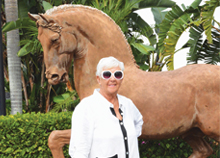Horse Show Official Ensures That The Competition Stays On A Level Playing Field
In the hunter/jumper show ring, horse and rider combine as a single athletic team to compete. As a steward and schooling supervisor, Marilyn Hart — known as “Mesa” to her friends — ensures adherence to the rules of fair competition in the warm-ups and contests, as well as protecting the horses’ welfare.
A transplant originally from Minnesota, Hart has resided in Florida for the past 20 years and enjoys living and working in Wellington.
“I started riding as an older adult and worked my way up from lunge line to amateur/owner, where, thanks to my horse Dylan, I was quite successful,” Hart recalled.
When the cost to maintain a horse and compete became a challenge, Hart decided to stay in the industry. “More specifically, I chose the hunter/jumper venue, by working and receiving my steward’s and schooling supervisor licenses,” Hart explained.
Hart is licensed by the United States Equestrian Federation, the sport’s national sanctioning organization. The schooling supervisor oversees the warm-up ring to watch that everything going on is fair and legal.
“My job as a schooling supervisor entails trying to maintain a level playing field for all exhibitors involved by making sure no illegal jumps are set and jumped; watching for signs of an exhausted horse; and, of course, being ever watchful of abusive behavior by any given rider or trainer,” Hart said. “It’s all about the rules of competition and the welfare of the horse.”
Hart also greatly enjoys when she works the competition rings as an official steward. During the Winter Equestrian Festival, four stewards cover the 12 rings.
“I love my job as steward because I wanted to stay involved with the horses and the special culture that I have grown to love in the horse world,” Hart said. “Being a steward satisfied my love of the sport.”
Stewards play a crucial role at the show grounds.
“One of the most important jobs is to be an objective liaison between horse show management, the exhibitor and the governing body, the United States Equestrian Federation,” Hart explained. “We, as stewards, have a lot of communication between exhibitors, judges, course designers and horse show management.”
Stewards are also instrumental in interpreting and enforcing the rules.
“As a steward, probably most important of all our duties is to interpret ever-changing rules to an exhibitor who may be confused as to the interpretation and or intent of any given rule,” Hart said. “And, of course, the other very important part is the measuring of horses and ponies to assure they are competing in the proper division.”
Horses and ponies are measured in “hands,” said Hart, who explained that one hand equals four inches. A small pony is 12.2 hands and under, a medium pony is over 12.2 hands up to 13.2 hands, and a large pony is over 13.2 hands up to 14.2 hands. Anything over 14.2 hands is a horse. When juniors under 18 compete in the junior hunter division, their horses are measured by large and small juniors. A small junior horse is under 16 hands but over 14.2, and a large junior horse is anything over 16 hands.
“Horses and ponies must be measured until they are eight years of age, at which time, they receive a standard card and do not require further measurement unless height is protested,” Hart said.
Hart enjoys the variety of people and techniques she deals with in her profession.
“Another important part of being a steward is we are able to observe many different styles of training and, of course, the very important clinics and exhibitions given by great and famous trainers and riders,” she said.
Hart is also very mindful that equestrian sports are international in nature.
“We are privileged to meet many different people from many different countries who compete, officiate, observe or train,” she said. “One part of stewarding that I find most rewarding is meeting so many different people, from judges, trainers, riders, parents, farriers, grooms and the list goes on and on.”
On a personal level, Hart has three children and five grandchildren. Only one child chose to live the “horsey” lifestyle.
“She has a large show barn in Minnesota, shows in the jumpers, and is a USEF judge,” Hart said.
Hart enjoys the small town feel of Wellington. “During the months of January through April, this quiet village turns into a horse haven when Wellington is host to the largest equestrian festival anywhere in the United States,” she said.
Hart invites the community to visit the world’s premier equestrian destination. “Come and see the very high jumps at Saturday Night Lights at the Palm Beach International Equestrian Center,” she said. “There are many activities for the entire family.”
